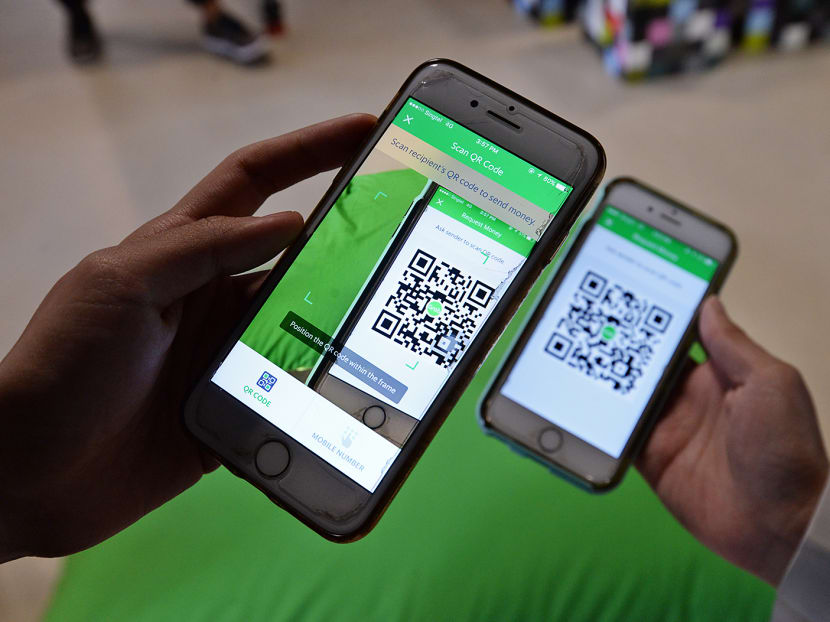GrabPay to extend e-payments to food, retail, other services
SINGAPORE — Ride-hailing firm Grab will expand its payment platform beyond transport to allow users to pay for food, beverage, retail, entertainment and other goods and services with GrabPay credits.
SINGAPORE — Ride-hailing firm Grab will expand its payment platform beyond transport to allow users to pay for food, beverage, retail, entertainment and other goods and services with GrabPay credits.
To be tested first in Singapore, the move, announced on Wednesday (Aug 30), will see Grab team up with more than 1,000 merchants by the end of this year. The company added that it is looking to join hands with merchants that are more heavily reliant on cash payments, such as hawker stalls and small retailers.
Speaking to reporters, Mr Jason Thompson, head of GrabPay, said the company is taking part in the Request for Information put up last week by the Government, as part of a push to develop e-payment solutions for hawker centres, coffee shops and other stores in the heartlands.
A study commissioned last year by the Monetary Authority of Singapore and conducted by business consultancy KPMG showed that cash formed more than 80 per cent of payments at small shops and neighbourhood stores, and about 90 per cent at hawker centres and wet markets.
At Grab, more than three-quarters of its users in Singapore pay for their rides daily via GrabPay, and 1 billion transactions are made through the platform yearly in the region, said Mr Thompson.
“In the coming months, (users) can look forward to using GrabPay to buy food or other goods and services from physical shops,” he added.
Mr Thompson said QR (quick-response) code payment will be one of the options for transactions between consumers and merchants, but did not disclose more details.
Earlier this month, TODAY first reported that Grab users will be able to transfer GrabPay credits to other users, paving the way for greater adoption of the payment platform.
The “peer-to-peer transfer” service was rolled out to Grab’s iOS customers Wednesday, and the feature will be extended to Android users after Sept 4.
To transfer credits to others, users key in a recipient’s mobile number tagged to their Grab account or scan a QR code in the Grab app if the recipient is nearby.
Mr Thompson said the new feature will allow users to split bills and pay for their share in GrabPay credits, or send credits as gifts to other users during festive occasions, for instance.
On the push towards cashless transactions, he noted that a barrier to adoption for merchants, especially smaller ones, was “a lot of clutter” brought on by various payment terminals.
Trust among consumers was also key for payment platforms. Pointing to the high proportion of its users already using GrabPay, Mr Thompson said: “We’re already breaking down those barriers.”
Grab said merchants could also stand to gain from wider marketing exposure on its app and expect “lower costs of cashless adoption”, although the firm declined to reveal the extent of cost savings when asked.
Mobile payments also mean businesses will not incur costs from renting payment terminals, for instance, Grab added.
Research manager Michael Yeo, from IDC Financial Insights, noted that unlike other payment providers that build payment tools before wooing users, Grab has an “arguably much simpler process” with its large pool of users who already have payment details stored in the app.
“Grab’s sheer scale in its user numbers is what instantly makes it a potential formidable player in the payments field,” said Mr Yeo.
Frost & Sullivan vice-president for digital transformation Ajay Sunder said GrabPay has gained “a lot more momentum” lately, and larger volumes will bring down transaction fees for merchants, given the shift away from traditional credit cards.
Mr Yeo said hawkers and smaller retailers are “natural first targets” because they rarely have card-acceptance capabilities, owing to attendant fees and costs.
Grab could offer a lower-cost alternative that requires minimal investment for retailers, he said.
To begin with, Mr Sunder pointed out that such retailers, which typically deal with “micro-transactions”, are traditionally not targeted by bigger traditional payment providers.
But retailers would be keen on an alternative mode of payment and consumers would enjoy the ease of not having to fumble for cash.
However, Mr Yeo also noted that competition involving various modes of payments is heating up rapidly, and the payments space here has grown “extremely crowded” in the past few months, and this may have resulted in “some ... consumer fatigue or disinterest”.
The use of cards for payments here is also very high, and the potential for such mobile payments to displace cards completely is “unlikely”, he added.
“The real potential for Grab will be in emerging markets such as Indonesia and Vietnam where card penetration is lower,” Mr Yeo said.
Separately, Grab said Wednesday that Toyota Tsusho, a general trading company under the Toyota Group, was the latest firm to invest in Grab as the ride-hailing firm seeks to raise US$2.5 billion (S$3.4 billion) in a record round of new fund-raising announced last month.
Also, a partnership between Grab and Toyota Motor Corporation, Toyota Financial Services Corporation and Aioi Nissay Dowa Insurance Co will see Grab share data on driving patterns from 100 Toyota cars in its fleet. Toyota will analyse the data and recommend how other services offered via the Japanese firm’s Mobility Services Platform, such as user-based insurance and predictive maintenance, could improve driver experience.









